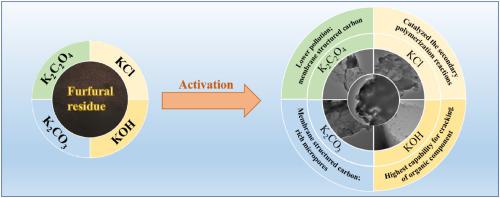Journal of Cleaner Production ( IF 9.7 ) Pub Date : 2022-04-27 , DOI: 10.1016/j.jclepro.2022.131936 Zhaobing Fu 1 , Kai Sun 1 , Huailin Fan 1 , Chao Li 1 , Hong Liu 1 , Shu Zhang 2 , Kuan Ding 2 , Guanggang Gao 1 , Xun Hu 1

|
Furfural residue is a solid waste produced in manufacturing furfural from biomass like corncob, which can be converted into liquid/gaseous fuel and activated carbon via chemical activation. In this study, in addition the pore structure of activated carbon, the impacts of varied potassium salts (KCl, KOH, K2CO3 and K2C2O4) on the properties of gases and bio-oil formed during activation of Furfural residue was studied. The results showed that the potassium salts suppressed cracking of condensable volatiles into gases, producing more bio-oil at expense of gases. KOH showed the highest activity for cracking, producing the lowest yield of activated carbon (4.8%) without activator with lower degree of crystallization than that K2CO3 and K2C2O4 as activators (20.1% and 26.9%). The activated carbon activated with K2CO3 or K2C2O4 showed the flaky membrane structure packed with varied layers, but not with KOH as the activator. K2C2O4, KOH and K2CO3 as the activators could promote cracking, deoxygenation, dehydrogenation and aromatization reactions, generating abundant micropores, while KCl could not. In addition, K2C2O4 as the activator of furfural residue showed the least energy consumption and environmental impacts, while with KCl was highest. The results herein demonstrated the potential of furfural residue as feedstock for the production of activated carbon and liquid fuels.
中文翻译:

了解用不同钾盐化学活化糠醛残渣过程中产物和排放物的演变
糠醛渣是利用玉米芯等生物质制造糠醛时产生的固体废物,可通过化学活化将其转化为液体/气体燃料和活性炭。在这项研究中,除了活性炭的孔结构,各种钾盐(KCl、KOH、K 2 CO 3和 K 2 C 2 O 4) 对糠醛渣活化过程中形成的气体和生物油的性质进行了研究。结果表明,钾盐抑制了可冷凝挥发物裂解成气体,以牺牲气体为代价生产更多的生物油。KOH 表现出最高的裂解活性,产生的活性炭产率最低(4.8%),不含活化剂,结晶度低于作为活化剂的 K 2 CO 3和 K 2 C 2 O 4(20.1% 和 26.9%)。用K 2 CO 3或K 2 C 2 O 4活化的活性炭显示了由不同层组成的片状膜结构,但没有 KOH 作为活化剂。K 2 C 2 O 4、KOH和K 2 CO 3作为活化剂可以促进裂解、脱氧、脱氢和芳构化反应,产生丰富的微孔,而KCl则不能。此外,作为糠醛残渣活化剂的K 2 C 2 O 4的能量消耗和环境影响最小,而KCl 最高。本文的结果证明了糠醛残渣作为生产活性炭和液体燃料的原料的潜力。


















































 京公网安备 11010802027423号
京公网安备 11010802027423号